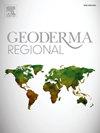Soil organic carbon stocks in the forested regions of Mongolia and its mitigation potential
IF 3.3
2区 农林科学
Q2 SOIL SCIENCE
引用次数: 0
Abstract
Soils represent the largest terrestrial carbon pool globally, with a significant proportion of this carbon stored in forest soils. Mongolia's forest area represents 0.45 % of the world's total forest cover. Research on the variability of SOC stocks within forest soil groups remains limited. This study aimed to address the SOC stock variations and retention capasities among groups of soils including Umbrisols (Gelic), Leptic Umbrisols, Mollic Umbrisols, Gleyic Umbrisols, and Podzols (Arenic). A total of 1558 soil samples from 316 soil profiles were collected in the Mongolian forest. The SOC stock was calculated from key parameters on SOC content, bulk density, and gravel content for each horizon. Then, the calculated SOC stock was standardized to the following depths: 0–30 cm, 30–60 cm, 60–100 cm, and 0–100 cm depth layers using a weighted average method. Mean SOC stock in 0–100 cm across all groups of forest soil was 88.5 Mg C ha−1. SOC stocks ranged between 59 and 141.0 Mg C ha−1 and varied significantly across soil groups (ANOVA: F = 22.9, p < 0.001). Gleyic Umbrisols, predominantly found on the northern foot slopes of mountain, exhibited the highest SOC stock. In contrast, Podzols (Arenic) in sandy forest areas had the lowest SOC stock. Leptic Umbrisols, the most widespread forest soil in Mongolia, had an average SOC stock of 78.6 Mg C ha−1. Across all soil groups, over 57.7–78.1 % of the SOC stocks was found in the first 30 cm emphasizing the critical role of this layer in carbon sequestration. The total SOC stock in Mongolian forest soils is estimated at approximately 1.24 petagrams (Pg). Furthermore, forest soils have the potential to sequester up to an additional 0.68 Pg of SOC. These results offer the first national scale SOC baseline for Mongolia's forests. The results on mitigation potentials highlight the importance of soil group specific management for carbon sequestration.
蒙古森林地区土壤有机碳储量及其缓解潜力
土壤是全球最大的陆地碳库,其中很大一部分储存在森林土壤中。蒙古的森林面积占世界森林总面积的0.45%。森林土壤中有机碳储量的变异研究仍然有限。摘要本研究旨在探讨不同土壤类型(含有机质有机质)、含有机质有机质、含有机质有机质、含有机质有机质、含有机质有机质、含有机质有机质、含有机质有机质、含有机质有机质、含有机质有机质、含有机质有机质、含有机质有机质、含有机质有机质、含有机质有机质、含有机质有机质、含有机质有机质、含有机质有机质、含有机质有机质、含有机质有机质、含有机质有机质、含有机质有机质、含有机质有机质、含有机质有机质、含有机质有机质、含有机质有机质、含有机质有机质、含有机质有机质)的变化。在蒙古森林共采集了316个土壤剖面的1558个土壤样品。根据每个层位的有机碳含量、体积密度和砾石含量等关键参数,计算出了有机碳储量。然后,采用加权平均法将计算得到的SOC储量标准化到0-30 cm、30-60 cm、60-100 cm和0-100 cm深度层。各森林土壤0 ~ 100 cm的平均有机碳储量为88.5 Mg C ha−1。土壤有机碳储量在59 ~ 141.0 Mg C ha - 1之间,不同土壤组间差异显著(方差分析:F = 22.9, p <;0.001)。Gleyic Umbrisols主要分布在山的北坡,其碳储量最高。相比之下,沙林区灰藻(Arenic)的有机碳储量最低。蒙古森林土壤中分布最广的松松林土壤的平均有机碳储量为78.6 Mg C ha−1。在所有土壤类群中,超过57.7% - 78.1%的有机碳储量分布在前30 cm,强调了这一层在固碳中的关键作用。蒙古森林土壤的总有机碳储量估计约为1.24百克(Pg)。此外,森林土壤有可能额外封存0.68 Pg的有机碳。这些结果为蒙古森林提供了第一个国家尺度的有机碳基线。关于减缓潜力的结果强调了土壤组特定管理对碳固存的重要性。
本文章由计算机程序翻译,如有差异,请以英文原文为准。
求助全文
约1分钟内获得全文
求助全文
来源期刊

Geoderma Regional
Agricultural and Biological Sciences-Soil Science
CiteScore
6.10
自引率
7.30%
发文量
122
审稿时长
76 days
期刊介绍:
Global issues require studies and solutions on national and regional levels. Geoderma Regional focuses on studies that increase understanding and advance our scientific knowledge of soils in all regions of the world. The journal embraces every aspect of soil science and welcomes reviews of regional progress.
 求助内容:
求助内容: 应助结果提醒方式:
应助结果提醒方式:


